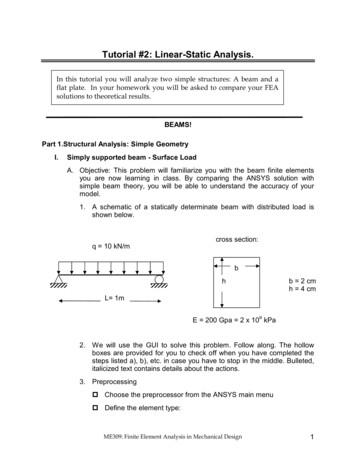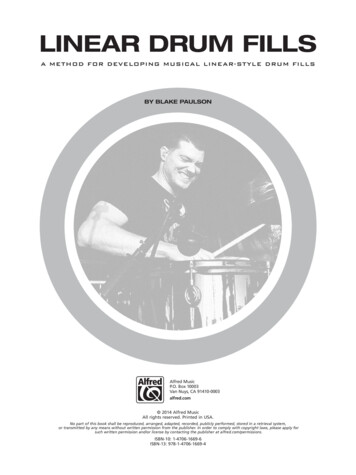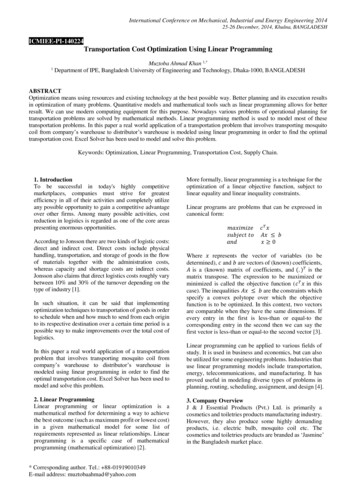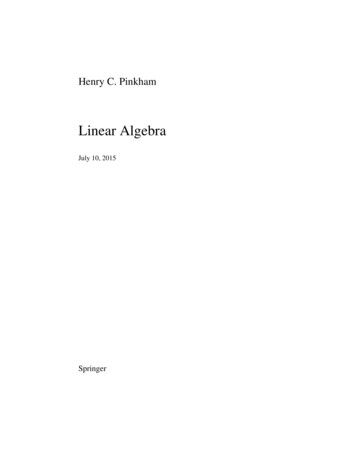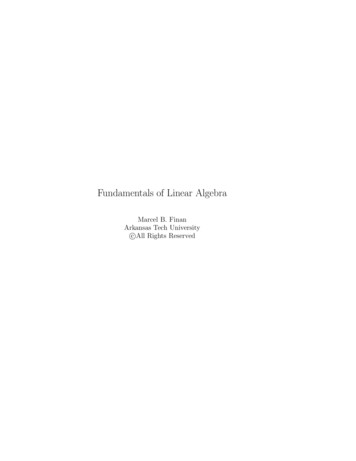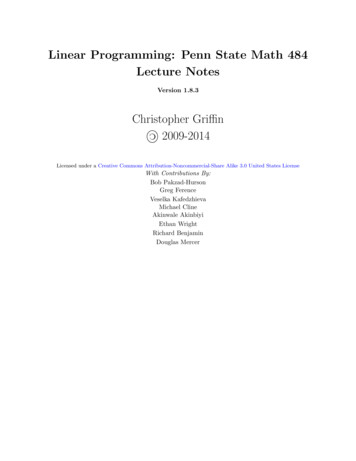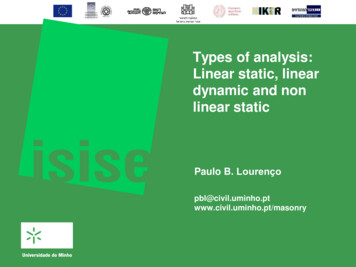
Transcription
המועצה לשימור אתרי מורשת בישראל Types of analysis:Linear static, lineardynamic and nonlinear staticPaulo B. sonry
המועצה לשימור אתרי מורשת בישראל SafetyAssessment ofExisting Buildings
Types of analysis: Linear static, linear dynamic and non linear staticPaulo B. Lourenço Non-linear static analysis Linear static analysisInstitute for Sustainability and Innovation in Structural EngineeringSimplificationStructural Analysis Methods (Static) 3
Paulo B. LourençoTypes of analysis: Linear static, linear dynamic and non linear static Early Structural Analysis “Ut tensio sic vis” or / E is the elasticity law established by R.Hooke in 1676.The theory is so extensively used that its limitations anddeficiencies are often forgotten. This is in opposition with early forms oflimit analysis.BPACantilever beam according to Galileo (1638) and evolutionof the “hypothesis” for the stress distribution at ABInstitute for Sustainability and Innovation in Structural EngineeringRetaining wall accordingto Coulomb (1773)4
Types of analysis: Linear static, linear dynamic and non linear staticPaulo B. Lourenço Modern Structural Analysis As structural collapse does not generally coincide with the appearanceof the first crack or localized early crushing, it seems that the elasticitytheory is a step back with respect to limit analysis Full nonlinear analysis (the most advanced form of structural analysis)covers the complete loading process, from the initial “stress-free” state,through the weakly nonlinear behavior under service loading, up to thestrongly nonlinear behavior leading to collapse Interest has been growing since 1970’s but it remains a field forselected (few) specialists due to complexity (knowledge) and costs(time) involved The possibilities are immense and several commercial softwarepackages include some form of nonlinear behavior, but an incorrect usecan be very dangerousInstitute for Sustainability and Innovation in Structural Engineering5
Paulo B. LourençoTypes of analysis: Linear static, linear dynamic and non linear static Modern Structural Analysis The modern use of nonlinear analysis focuses mostly on these threefields: Complex / stringent safety requirement structures (e.g. nuclear plants,dams, bridges) Virtual laboratory for parametric studies Existing structures (evaluation, repair, rehabilitation) Three types of non-linearities may arise: F Concrete(“code model”) Steel(“code model”) Material (or physical) nonlinearityInstitute for Sustainability and Innovation in Structural EngineeringGeometricalnonlinearityContact nonlinearity6
Types of analysis: Linear static, linear dynamic and non linear staticPaulo B. LourençoExisting BuildingsVehiclesVertical dead live loadSettlementsInstitute for Sustainability and Innovationin Structural Engineering 7
Types of analysis: Linear static, linear dynamic and non linear staticPaulo B. LourençoModern Earthquake DesignElastic analysis leadsto excessivelyconservativesolutions forunreinforced,confined, andpossibly, reinforcedmasonry“Storey” model (Por)TomazevicFinite element model(Many authors)Macro-models (Braga, Liberatore, D’Asdia, Magenes, Lagomarsino, etc.)Institute for Sustainability and Innovation in Structural Engineering 8
Types of analysis: Linear static, linear dynamic and non linear staticPaulo B. Lourenço Example of Analysis of an ArchRobert Hooke (1635-1703)- Principle of the inverted catenaryIn 1675 Hooke provided the solution for heequilibrium of an arch by means of ananagram included in the book "Adescription of Helioscopes and someother Instruments", which was onlydeciphered after his death in 1703.The solution: “Ut pendet continuum flexile, sicstabit contiguum rigidum inversum” – as hangs theflexible line, so but inverted will stand the rigid arch.Institute for Sustainability and Innovation in Structural Engineering9
Types of analysis: Linear static, linear dynamic and non linear staticPaulo B. Lourenço 10Graphic StaticsThe arch is first decomposed in a series of real or fictitious voussoirsseparated by a series of planes (the planes do not need to be parallel)The thrust line is defined as the geometrical locus of the points ofapplication of the sectional forces (the resulting forces over each planebetween voussoirs) across the archAn arch is stable if it is possibleto find a thrust line containedbetween its boundariesInstitute for Sustainability and Innovation in Structural Engineering
Types of analysis: Linear static, linear dynamic and non linear staticPaulo B. Lourenço 11Kinematic AnalysisCharles-Agustin COULOMB (1736-1806) proposed in 1773 the first generaland accurate theory on the stability of masonry archesThe basic assumptions are:(1) Sliding between voussoirs is unlikely due to the existing frictional forces(2) Collapse will be caused by the rotation between parts due to theappearance of a number of hinges. The location of the hinges is a prioriunknown but can be determined by the method of “maxima and minima”Institute for Sustainability and Innovation in Structural Engineering
Types of analysis: Linear static, linear dynamic and non linear staticKinematics of 4-hinge collapseInstitute for Sustainability and Innovation in Structural EngineeringPaulo B. Lourenço 12
Types of analysis: Linear static, linear dynamic and non linear staticPaulo B. LourençoCorrespondence with THRUST LINE theory: a hinge will develop eachtime the equilibrium line becomes tangent to an alternate boundary. Inthis condition (failure), the thrust line is determined and unique.Institute for Sustainability and Innovation in Structural Engineering 13
Types of analysis: Linear static, linear dynamic and non linear staticPaulo B. LourençoCollapse of an arch brought experimentally to failureInstitute for Sustainability and Innovation in Structural Engineering 14
Paulo B. LourençoTypes of analysis: Linear static, linear dynamic and non linear static 15Static Analysis Methods (I) Linear Elastic Analysiselastic properties maximum admissiblestress1.2510 kN2.53 Kinematic Collapse Mechanism Analysisinelastic properties friction angle tensile and compressive strengths Static Thrust Line Analysis5 Non-linearAnalysis(PhysicalandCombined)FULL inelastic properties (ft 0 and ft 0) elastic propertiesInstitute for Sustainability and Innovation in Structural Engineering
Static Analysis Methods (II)Types of analysis: Linear static, linear dynamic and non linear staticPaulo B. LourençoMax. 0.64 N/mm2Linear ElasticKin. load factor : 1.8Failure MechanismMin. -1.0 N/mm2Linear ElasticGeo. load factor : 1.2Thrust LineMin. -5.4 N/mm2Phys. Non-LinearInstitute for Sustainability and Innovation in Structural EngineeringMin. -5.4 N/mm2Comb. Non-Linear 16
Paulo B. LourençoTypes of analysis: Linear static, linear dynamic and non linear staticStatic Analysis Methods (III)3.0Load factor2.52.01.5Limit analysisft 0, Physically non-linear1.0ft 0, Physically / Geometrically non-linearft 0.2 N/mm2, Physically non-linear0.5ft 0.2 N/mm2, Physically / Geometrically non-linear0.00510Vertical displacement at quarter span (mm)Institute for Sustainability and Innovation in Structural Engineering15 17
Types of analysis: Linear static, linear dynamic and non linear staticPaulo B. Lourenço 18Static Analysis Methods (III)Approach/Analysis typeSemi-circular archAllowable stresses (fta 0.2 N/mm2)Kinematic limit analysisGeometric safety factorft 0, Physically non-linearft 0, Physically and geometrically non-linear0.311.81.21.81.7ft 0.2 N/mm2, Physically non-linearft 0.2 N/mm2, Phys. and geom. non-linear2.52.5 The “safety factors” of a linear elastic analysis and a static limit analysis cannotbe compared with the remaining safety factors. Physically non-linear analysis and kinematic limit analysis yield the same failuremechanisms and safety factors? The consideration of a non-zero, yet low and degrading, tensile strengthincreased the safety factors considerably. The post-peak is a key issue. Different methods of analysis lead to different safety factors and differentcompleteness of results.Institute for Sustainability and Innovation in Structural Engineering
Types of analysis: Linear static, linear dynamic and non linear staticPaulo B. Lourenço 19More on Static Analysis Methods Safety factor: 124%Institute for Sustainability and Innovation in Structural Engineering
Types of analysis: Linear static, linear dynamic and non linear staticPaulo B. LourençoStructural Analysis Methods: “Dynamic” Non-linear static analysis Linear elastic time history analysis Modal superposition Linear static analysisInstitute for Sustainability and Innovation in Structural EngineeringSimplification Non-linear time history analysis 20
Types of analysis: Linear static, linear dynamic and non linear staticPaulo B. Lourenço 21Push-Over Analysis (I) In the recent years new methods of seismic assessment and design havebeen developed, particularly with respect to push-over analysis Two methods of analysis can be distinguished:- Traditional force method, combined with control of performance requirementsbased on deformation- Displacement based method, in which the analysis starts by defining a targetdisplacement (measuring the structural response).Institute for Sustainability and Innovation in Structural Engineering
Types of analysis: Linear static, linear dynamic and non linear staticPaulo B. Lourenço 22Push-Over Analysis (II)Traditional Force Method The dimensions of the structural members are considered The stiffness of the members is also considered (the codes might considerelastic stiffness or 30 to 50% of the elastic stiffness) Periods are based on stiffness (Note: The design forces can be reducedabout 30 to 50% if the stiffness is reduced to the half) Forces are distributed in the elements according to the stiffnessInstitute for Sustainability and Innovation in Structural Engineering
Paulo B. LourençoTypes of analysis: Linear static, linear dynamic and non linear staticMoment (kNm)Moment (kNm)Push-Over Analysis (III)Curvature (1/m)Percentage of reinforcement 1%Curvature (1/m)Percentage of reinforcement 3%Moment-curvature curves for circular columns (D 2 m, fc 35 MPa, fy 450 MPa)Stiffness and strength are correlated!!Institute for Sustainability and Innovation in Structural Engineering 23
Paulo B. LourençoTypes of analysis: Linear static, linear dynamic and non linear static 24Push-Over Analysis (IV) FHAHBHcHCHACHBA BForce Based DesignDisplacement Based DesignStiffness:proportional to 1/H3proportional to 1/HShear:proportional to 1/H3proportional to 1/HMoment:proportional to 1/H2equalReinforcement:proportional to 1/H2equalDuctility:equal (!)Institute for Sustainability and Innovation in Structural Engineeringproportional to 1/H2
המועצה לשימור אתרי מורשת בישראל MasonryStructures WithBox Behavior
Types of analysis: Linear static, linear dynamic and non linear staticPaulo B. LourençoRecent test results: Rigid diaphragm Worst case scenario: Embedded ring beam Unfilled vertical joints Moderate damage up to 100% of the design earthquake in Lisbon Ductile failure for 250% of the design earthquake in LisbonInstitute for Sustainability and Innovation in Structural Engineering 26
Types of analysis: Linear static, linear dynamic and non linear staticPaulo B. Lourenço Experimental results show thatURM possesses considerablecapacity for inelasticdeformations, and then theapplication of nonlinear analysisis obvious Seismic pushover analysis simulates the evolution of the condition ofstructures during earthquakes, through application of incrementalhorizontal forces until collapse Assumptions of box behaviour and in-plane response are consideredInstitute for Sustainability and Innovation in Structural Engineering 27
Types of analysis: Linear static, linear dynamic and non linear staticPaulo B. Lourenço 28“POR” Storey Mechanism Developed in former Yugoslavia and Italy as a reaction of the Skopje earthquakein 1963, and implemented in the region Friuli-Venezia Giulia after the Friuliearthquake in 1976 (DT2, 1977) The following hypothesis are considered: Thickness of the wall is constant in each level Slabs are rigid in-plane diaphragms Ends of the piers do not rotate, but only suffertranslation Behavior of the piers is elastic-perfectly plastic, with apredefined ductility Elastic stiffness of each panel remains constant Panels collapse by diagonal shear according theTurnsek-Cacovic expressionTomaževič, Braga & DolceInstitute for Sustainability and Innovation in Structural Engineering
Paulo B. LourençoAdditional Macro-MechanismsSince the 1980s, observation of damage in masonrybuildings subjected to significant vertical load due to useof slabs, and constituted by slender piers, introduces anew trend of research on the combined flexural mechanismDimensionless normal stress (σ/fm)Types of analysis: Linear static, linear dynamic and non linear static10.75Combinedflexural0.5Diagonal shear0.25Sliding000.511.5Slenderness (H/L)Comb. flexuralDiagonal shearInstitute for Sustainability and Innovation in Structural EngineeringSliding shear 29Mixed22.5
Types of analysis: Linear static, linear dynamic and non linear staticPaulo B. LourençoEarly Improvements in Italy Initially these methods only had an impact in the scientific community and thePOR persisted as the method most used by Italian designers1RAN(Raithel & Augenti)PEFV(D’Asdia & Viskovic)Institute for Sustainability and Innovation in Structural Engineering23MAS3D(Braga et al.) 30
Types of analysis: Linear static, linear dynamic and non linear staticPaulo B. LourençoA Generation of Design Methods in Italy As a consequence of the 2002 Molise Earthquake the new Italian code OPCM3274/2003(3431/2005) was introduced, and macro-elements methods emerge asmodern and practical toolsSpandrelPierJointSAM(Magenes et al.)3Muri(Lagomarsino et al.)Institute for Sustainability and Innovation in Structural Engineering3DMacro(Caliò et al.) 31
Types of analysis: Linear static, linear dynamic and non linear staticValidation ExampleInstitute for Sustainability and Innovation in Structural EngineeringPaulo B. Lourenço 32
Types of analysis: Linear static, linear dynamic and non linear staticOr even use SAP 2000One-dimensional macro-elementBi-dimensional macro-elementInstitute for Sustainability and Innovation in Structural EngineeringPaulo B. Lourenço 33
Types of analysis: Linear static, linear dynamic and non linear staticPaulo B. Lourenço 34Commercial Software (I)There is commercial software available for structural UR masonry, particularlyin Italy. Benchmarking was made in two publications: Azores 1998, Eds. C.Sousa Oliveira et al., (2008) and Marques, R., Lourenço, P.B., Possibilities andcomparison of structural component models for the seismic assessment ofmasonry buildings, Computers and Structures, 89 (21-22), p. 2079-2091 (2011)ProgramAEDESCMT LFEDRAWIN-Statik MurDim Por 2000TQS alianApproachWeb adressFEM and st.htmFEMwww.arktec.com/new t13.htmFEMwww.arktec.com/new t17.htmStorey Mech. ndilwallStorey Mech.www.softwareparadiso.it/murats.htmStorey Mech.www.franiac.it/sismur.htmlStorey Mech.www.logical.it/software travilog.aspxStorey Mech.www.tecnobit.info/products/murature.phpFEM and SCM www.stsweb.net/STSWeb/ITA/homepage.htmInstitute for Sustainability and Innovation in Structural Engineering
Types of analysis: Linear static, linear dynamic and non linear staticCommercial Software (II) Efficient and high level modelingInstitute for Sustainability and Innovation in Structural EngineeringPaulo B. Lourenço 35
Paulo B. LourençoTypes of analysis: Linear static, linear dynamic and non linear staticDisplacement Based Design Recent methods implement capacity/displacement-based seismic design, byevaluating the evolution of damage and displacement If the damage evolution can beused as a measure of seismicperformance, the confrontationbetween displacement capacityand displacement demand is therule for safety lobjectsStructuralcharacteristicsAutomaticmesh definitionEquivalentmesh/frame definitionNon-linearanalysisA – DisplacementcapacitySeismicparametersB – DisplacementdemandBase shear (kN)400300200100Final analysis0010203040Displacement (mm)Institute for Sustainability and Innovation in Structural Engineering 36
Types of analysis: Linear static, linear dynamic and non linear staticPaulo B. LourençoEnergy Dissipation Capacity (I)In a force based method, the non-linear reserve capacity must be consideredFor unreinforced masonrybuildings with 2 or more storeys:EC8:q 1.5-2.5 (recommended 1.5)OPCM 3431:αu /α1 (OSR) 1.8q q0 x OSR 3.6Institute for Sustainability and Innovation in Structural Engineering 37
Types of analysis: Linear static, linear dynamic and non linear staticEnergy Dissipation Capacity (II)Institute for Sustainability and Innovation in Structural EngineeringPaulo B. Lourenço 38
Types of analysis: Linear static, linear dynamic and non linear staticPaulo B. LourençoEnergy Dissipation Capacity (III) É necessário ter em conta a reserva de capacidade não linear das estruturas emductilidadePara edifícios em alvenariasimples com 2 ou mais pisos:EC8:q(0) 2.0OPCM 3431:αu /α1 (OSR) 1.8q q0 x OSR 3.6Institute for Sustainability and Innovation in Structural Engineering 39
המועצה לשימור אתרי מורשת בישראל Application
Paulo B. LourençoTypes of analysis: Linear static, linear dynamic and non linear static 41PARAMETRIC STUDY on the NR. of STOREYS (I)Specific weight , γ17.0 kN/m3Compressive characteristic strength , fk2.56 MPaSliding pure shear characteristic strength, fvk00.15 MPaNormal elasticity module, E2560 MPaTangential elasticity module, G1024 MPa1.00Dl 6.0 kN/m2; Ll 1.0 kN/m2Dead load 6.0 kN/m2Live load 1.0 09.00Dl 7.0 kN/m2; Dl 2.0 kN/m2Dl 7.0 kN/m2; Ll 2.0 kN/m22.002.003.006.00Dead load 6.0 kN/m2Live load 1.5 kN/m21.50Dl 7.0 kN/m2; Ll 2.0 kN/m26.50Institute for Sustainability and Innovation in Structural Engineering6.50UndamagedPlastic by shearFailure by shearPlastic by flexuralFailure by flexural
Types of analysis: Linear static, linear dynamic and non linear staticPaulo B. Lourenço 42PARAMETRIC STUDY on the NR. of STOREYS (II)Pushover AnalysisagRZone Soil (m/s2)1.1 A 2.50B1.2 A 2.00B1.31.41.5S1.001.201.001.20agRZone Soil (m/s2)ABAB1.50 1.001.201.00 1.001.302.3AB0.50 1.001.302.52.4SA1.70 1.00BABAB1.351.10 1.001.330.80 1.001.35Elastic Analysis ac. PT NA to EC8 (q 1.5) Elastic Analysis ac. IT OPCM 3431q q0 UnsafeFyFel q 0 OSRSafe in soil type AInstitute for Sustainability and Innovation in Structural EngineeringSafe in soil types A and B
המועצה לשימור אתרי מורשת בישראל MasonryStructuresWithout BoxBehavior
Types of analysis: Linear static, linear dynamic and non linear staticPaulo B. Lourenço 44Recent Tests: Flexible Diaphragm “Gaioleiro”-type structure (late 19th century / early 20th century) Moderate damage for 100% of the design earthquake in Lisbon Light strengthening and collapse for 150% of the design earthquake in LisbonInstitute for Sustainability and Innovation in Structural Engineering
Types of analysis: Linear static, linear dynamic and non linear staticPaulo B. LourençoQutb Minar 4528.9671.4815.3912.427.736.983.13Location: New Delhi (India)Material: MasonryTotal Height: 72.5 mCrosss section: shell (3 leaves) core (2 leaves)Institute for Sustainability and Innovation in Structural Engineering14.07
Paulo B. LourençoTypes of analysis: Linear static, linear dynamic and non linear static 46Numerical ental Frequencies [Hz]6.0FEMUMinhoAxialExperimentalFEM - UMinhoFEM - UPadovaFEM - g1.0Bending0.00CalibrationInstitute for Sustainability and Innovation in Structural Engineering12345Calculated Frequencies [Hz]67
Paulo B. LourençoTypes of analysis: Linear static, linear dynamic and non linear static 47Push-Over Analysis0.250.200.150.100.25Beam modelRigid modelSolid model0.05Mass ProportionalFac. scala: 5.00000 Paso 18100.000.00.20.40.60.81.0Load factor [base shear / self-weight]Load FactorD formada Dinamica minar t accct Linear Proportional0.201º Mode proportionalRigid - Plot V3.2.11.2Top Displacement [m]Uniform Mass DistributionCollapse at the l displacement [m]Other Mass DistributionsInstitute for Sustainability and Innovation in Structural Engineering0.8
Paulo B. LourençoTypes of analysis: Linear static, linear dynamic and non linear staticTime History Analysis0.61.5Seismic coefficient AhAcceleration [m/s 2]2.01.00.50.0-0.5-1.0-1.5-2.010th mode0.160.5First mode 1.260.40.30.20.10.0051015Time [s]2000.511.52Period [s]Five articificial accelerograms0.4700.3Collapse: 4thbalcony0.2Deslocamento horizontal [m]DBERecord 1Record 2Record 3Record 4Record 5Série7Série8Série9Second mode 0.500.160500H [m]-0.1-0.2Record 1Record 2Record 3Record 4Record 5Série6Série74030-0.320-0.45º balcão4º balcão3º balcão2º balcão1º balcão-0.5-0.6-0.71000-0.80510152025Tempo [s]FEM – Collapse for 0.20gInstitute for Sustainability and Innovation in Structural Engineering50100150200250Maximum excentricity(Bending Moment / Axial Load )300REM 48
Types of analysis: Linear static, linear dynamic and non linear staticPaulo B. Lourenço“Gaioleiro” BuildingLocation: LisboaMaterial: Masonry walls andtimber pavementsNo. of storeys: 4 to 6Numerical modelInstitute for Sustainability and Innovation in Structural Engineering 49
Types of analysis: Linear static, linear dynamic and non linear static“Gaioleiro” BuildingInstitute for Sustainability and Innovation in Structural EngineeringPaulo B. Lourenço 50
Paulo B. LourençoTypes of analysis: Linear static, linear dynamic and non linear static 51Pushover AnalysisTransversal DirectionLongitudinal Direction0.3[α h]Seismicde carga [λ]Factorcoefficient0.25[α h]de carga (λ)SeismicFactorcoefficient1Pushover 1st ModePushover MassDynamic0.20.150.10.05Pushover 1st ModePushover camentoDisplacement [m]Institute for Sustainability and Innovation in Structural o[m][m]0.02
Types of analysis: Linear static, linear dynamic and non linear staticTime History AnalysisNumerical modelε1 [m/m]Principal strains(external surface)Institute for Sustainability and Innovation in Structural EngineeringPaulo B. LourençoExperimental model 52
Types of analysis: Linear static, linear dynamic and non linear staticPaulo B. LourençoDesign and Assessment Macro-block analysis? Limit equilibrium analysis using the principle of virtual work is currentlyunderstood as the “best” analysis techniqueOverturningInstitute for Sustainability and Innovation in Structural Engineering 53
המועצה לשימור אתרי מורשת בישראל Conclusions
Types of analysis: Linear static, linear dynamic and non linear staticPaulo B. LourençoConclusions Design and assessment methods based on non-linear analysis should beused for masonry structures. Linear elastic analysis methods (application of“equivalent” static forces and modal superposition) are questionable Adequate models and commercial software, based on pushover analysis,are available for masonry with box behavior It was shown that pushover analyses do not simulate correctly the failuremode of masonry structures without box behavior, meaning that highervibration modes have a significant contribution Pushover analysis proportional to the mass are probably the best solution isglobal structural analysis models are used For design purposes, particularly for strengthening design, macro-block limitanalysis is probably the best analysis tool for practitioners More research needs to be done in the field of masonry structures withoutbox behavior and earthquakesInstitute for Sustainability and Innovation in Structural Engineering 55
המועצה לשימור אתרי מורשת בישראל Types of analysis:Linear static, lineardynamic and nonlinear staticPaulo B. sonry
Institute for Sustainability and Innovation in Structural Engineering Types of analysis: Linear static, linear dynamic and non linear static Paulo B. Lourenço 11 Kinematic Analysis Charles-Agustin COULOMB (1736-1806) proposed in 1773 the first general and accurate theory on the stability of masonry arches The basic assumptions are:


